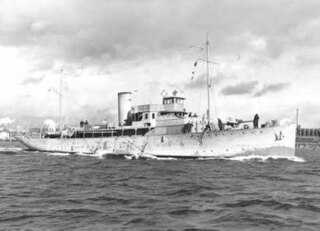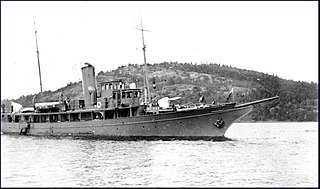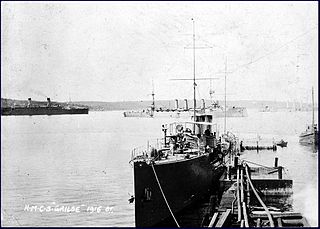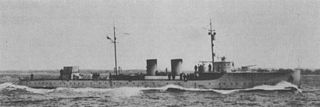 W
WHMCS Ambler was an armed yacht that was acquired by the Royal Canadian Navy during the Second World War as a patrol and training vessel. Constructed in 1922, Ambler was under private ownership until 1940 when the vessel was requisitioned for service in the Royal Canadian Navy. Initially used as a patrol vessel, Ambler was used as a training vessel until 1945. Following the war, Ambler was sold to private interests.
 W
WThe first USS Sabalo (SP-225) was a United States Navy patrol vessel in commission from 1917 to 1919. Following World War I, Sabalo was sold to private interests before returning to service as a patrol vessel in World War II, this time with the Royal Canadian Navy, renamed Cougar. Returning to private ownership following the war, the vessel sank in a hurricane in 1950.
 W
WHMCS Elk was an armed yacht serving with the Royal Canadian Navy during the Second World War. Prior to Canadian service, the ship was named Arcadia. She was used initially as a patrol vessel, but later saw use as a training and guard ship for submarines on the East Coast of Canada. Following the war, Elk was sold for commercial use and returned to her original name. She was renamed Grand Manan III in 1946 and used as a short-haul passenger ferry before being broken up in 1968.
 W
WHMCS Florence was a commissioned patrol vessel of the Royal Canadian Navy that served in the First World War. Originally launched as the yacht Czarina, she was acquired by John Craig Eaton in 1910 and renamed Florence. Following the outbreak of war, Eaton donated the yacht to the Royal Canadian Navy. The ship had a short career and proved unsuitable for navy work and was paid off in September 1916. The vessel was subsequently sold to buyers in Martinique, and was reportedly lost in the Caribbean Sea in January 1917.
 W
WHMCS Grilse was a commissioned patrol boat of the Royal Canadian Navy during the First World War. Launched in 1912 as the private yacht Winchester of the American industrialist Peter Rouss, the vessel was constructed along the lines of a contemporary Royal Navy torpedo boat destroyer. After the outbreak of war, vessels that could be used by belligerents was prohibited by the government of the then-neutral United States. Canadian millionaire J. K. L. Ross purchased Winchester and returned to Canada with the yacht, where he transferred ownership of the vessel to the Royal Canadian Navy. Renamed Grilse, a pseudonym for Atlantic salmon and converted to a patrol boat, the vessel was deployed as part of Canada's east coast patrol combating the German submarine threat. After the war, she was sold back to private interests, re-converted to a yacht and renamed Trillora. Trillora foundered in 1938 at Long Island, New York during a hurricane.
 W
WHMCS Hochelaga was a commissioned patrol vessel of the Royal Canadian Navy (RCN) that served in World War I and postwar until 1920. Hochelaga is a historic name associated with Canada, the voyages of Jacques Cartier, and the city of Montreal. Initially constructed as the yacht Waturus in 1900 in Europe, the vessel was sold to an American in 1902. The ship was acquired in 1914 for use as a patrol vessel on the East Coast of Canada. Following World War I, the vessel became a ferry between Prince Edward Island and Nova Scotia. After World War II the ship was renamed HaChayal Ha'Ivri and used for illegal Jewish immigration to Palestine. The vessel was scrapped in 1950.
 W
WHMCS Raccoon was an armed yacht that served in the Royal Canadian Navy during World War II. Purchased by the Royal Canadian Navy in 1940, the ship was originally known as the yacht Halonia. Used as a patrol vessel and convoy escort, the ship was sunk by the German submarine U-165 in the St. Lawrence River on 7 September 1942. Raccoon was escorting Convoy QS-33 at the time. The entire ship's crew was lost.
 W
WUSS Winchester (SP-156) was an armed yacht that served in the United States Navy as a patrol vessel from 1917 to 1919. Prior to and following World War I, Winchester was a private yacht, later renamed Renard. In World War II, Renard was requisitioned for use in the Royal Canadian Navy as a patrol vessel, keeping her name. She was returned to her owners in 1944.
 W
WThe first USS Sabalo (SP-225) was a United States Navy patrol vessel in commission from 1917 to 1919. Following World War I, Sabalo was sold to private interests before returning to service as a patrol vessel in World War II, this time with the Royal Canadian Navy, renamed Cougar. Returning to private ownership following the war, the vessel sank in a hurricane in 1950.
 W
WHMCS Stadacona was a commissioned patrol boat of the Royal Canadian Navy (RCN) that served in the First World War and postwar until 1920. Prior to entering service with the RCN, the vessel was the private yacht Columbia. Following the war, Stadacona performed hydrographic surveys. The vessel was sold for commercial use in 1920 and was burned for salvage in 1948. Stadacona is a historic name associated with Canada, the voyages Jacques Cartier, the colony of Samuel de Champlain, and Quebec City.
 W
WUSS Winchester (SP-156) was an armed yacht that served in the United States Navy as a patrol vessel from 1917 to 1919. Prior to and following World War I, Winchester was a private yacht, later renamed Renard. In World War II, Renard was requisitioned for use in the Royal Canadian Navy as a patrol vessel, keeping her name. She was returned to her owners in 1944.
 W
WHMCS Wolf was an armed yacht of the Royal Canadian Navy during World War II that saw service on the British Columbia Coast of Canada. Constructed in 1915 as the yacht Wenowah, with the US entry into World War I, the vessel was taken into United States Navy service as USS Wenonah (SP-165) as a patrol ship. The vessel escorted convoys between the United States and Europe and between Gibraltar and Bizerte, Tunis and Genoa, Italy. After the war, Wenonah was loaned to the United States Coast and Geodetic Survey for three and a half years before being sold to private interests in 1928. In private ownership, the vessel was renamed at least twice, including Stranger and Blue Water.
 W
W